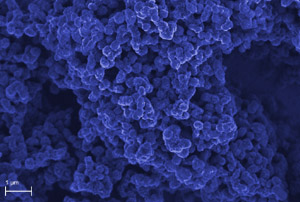Researchers from the Institute of Physical Chemistry of the Polish Academy of Sciences have conducted studies which suggest that carbon nanoparticles can be used to measure the amount of dopamine present in solutions even if there is interference due to the presence of ascorbic and uric acids.
 Microscope image of an electrode surface with 24 layers of polysilicate submicroparticles coated with carbon nanoparticles. Such electrodes, developed at the Institute of Physical Chemistry of the Polish Academy of Sciences in Warsaw, Poland, allow for dopamine sensing in solutions in the presence of interfering substances. Credit: IPC PAS
Microscope image of an electrode surface with 24 layers of polysilicate submicroparticles coated with carbon nanoparticles. Such electrodes, developed at the Institute of Physical Chemistry of the Polish Academy of Sciences in Warsaw, Poland, allow for dopamine sensing in solutions in the presence of interfering substances. Credit: IPC PAS
The carbon nanoparticles, which are deposited on silicate submicroparticles are used to cover the electrodes, and these electrodes in turn are used to measure the levels of dopamine.
Under this method, the carbon nanoparticle covered electrodes are dipped into solutions in which the samples are contained after which an electrical potential is introduced. The solutions either contain silicon submicroparticles or carbon nanoparticles. While carbon nanoparticles are charged negatively, silicon submicroparticles are charged positively and this creates electrostatic interactions between them. Repeated immersion of the nanoparticles into the solution created 24 layers of polysilicate submicroparticles.
Usually, dopamine signals are overshadowed by signals originating from ascorbic acids and uric acids. However under this method, the carbon nanoparticles modify the values at which the acids are oxidised. As a result, the dopamine signals get separated and are made visible. The procedure was able to detect even low dopamine concentrations of 10-7 mol/L even when interferences of 10-3 mol/L were present. Though the current methods and equipments of detecting dopamine are expensive, cheaper alternatives in the form of compact instruments are also available. These instruments can be installed with the electrodes in order to detect patient’s illness at a very short time period.